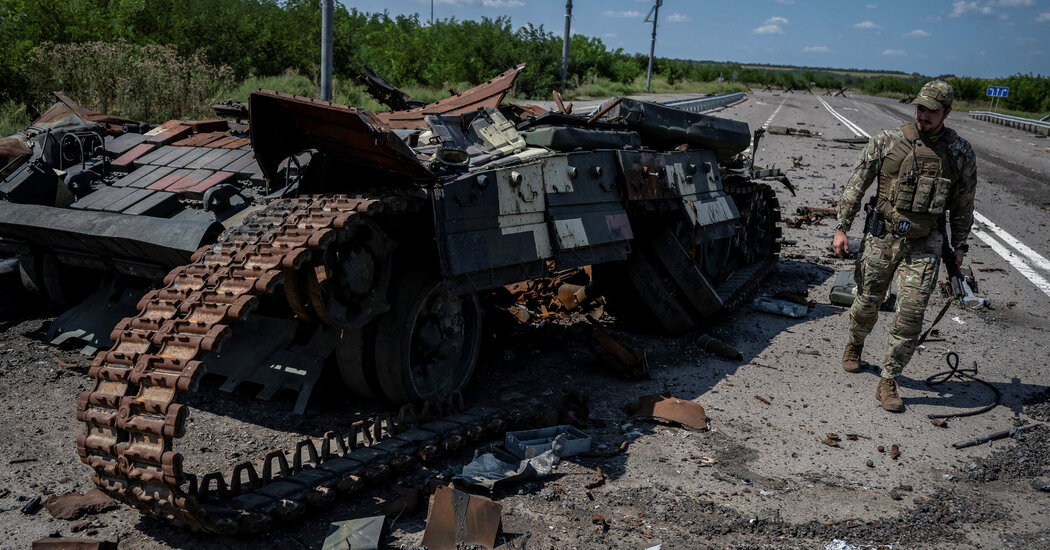Ukraine’s military said on Monday that its forces had retaken the southern village of Robotyne, a tactical victory that underlines the immense challenge Kyiv’s counteroffensive faces in punching through deep and dense Russian defenses.
The capture of Robotyne would mean that Ukrainian forces have penetrated the first layer of minefields, tank traps, trenches and bunkers installed by the Russians since they invaded, military analysts say, potentially creating new strategic opportunities.
But the Ukrainian counteroffensive that began in early June has advanced only a few miles southward to reach Robotyne, in intense fighting with heavy casualties and equipment losses, and a similar distance on another axis to the east. The ultimate target of the thrust to Robotyne is the city of Melitopol, about 45 miles farther south, and more layers of Russian defenses lie in the way.
“Robotyne has been liberated,” said Hanna Malyar, a Ukrainian deputy defense minister. She told the Military Media Center, a platform for Ukraine’s Ministry of Defense, that Ukrainian forces were now advancing southeast toward the villages of Novoprokopivka and Ocheretuvato despite “fierce resistance” from Russian forces.
The claims could not be independently confirmed. Russia’s Ministry of Defense on Monday reported fighting close to Robotyne. Rybar, an influential Russian military blogger, said that fighting was continuing in the village, without offering details, and disputed the Ukrainian claims of advances to the southeast.
The recapture of Robotyne, the first settlement Ukraine has claimed to seize in nearly two weeks, could help boost the Ukrainian public’s morale after grinding fighting that has produced only small gains. And Ukrainian officials say that even small advances are significant, allowing their artillery and missiles to strike deeper into Russian-held territory at Moscow’s troops, supplies and transportation networks.
But the Russian have a far superior long-range arsenal that is able to hit anywhere in Ukraine, a fact that they demonstrated overnight with a missile strike on an oil refinery more than 80 miles from the nearest Russian-held territory. Officials said the attack, in the village of Hoholeve, in the eastern Poltava region, killed three people and wounded five others, all refinery workers. One was missing.
“As a result of the explosion, the oil mill premises caught fire,” Andriy Yermak, the head of the Ukrainian president’s office, said in a post on the Telegram messaging app, alongside two pictures that showed a smoldering blaze and damage from its aftermath.
In Kryvyi Rih, a city in central Ukraine about 45 miles from the front, the authorities said that a missile strike had destroyed two cottages and damaged five others. And in the Kherson region, farther south, Russian shelling killed a 63-year-old woman, a local military official said.
Russian forces have been hitting Ukraine’s civilian infrastructure, particularly energy systems, since shortly after President Vladimir V. Putin launched the invasion 18 months ago. Strikes on oil plants led to nationwide fuel shortages last spring, and attacks on power plants and heating systems left many Ukrainians without electricity or heat over the winter.
In Kyiv, President Volodymyr Zelensky’s government is eager to show progress to its Western backers so they will keep supplying weapons and financial support.
Ukraine also wants to join NATO, but alliance leaders have made clear that will not happen as long as the conflict is underway, and even the longer-term prospects for membership are murky. In July, NATO said it would invite Ukraine to join at some point, but has not offered a timeline — essentially restating a commitment it made 15 years earlier.
Mr. Zelensky said on Sunday that he expected Washington to instead offer something like its relationship with Israel, which the United States designates as a “major non-NATO ally,” with a long-term commitment to supplying billions in military aid and cooperation on defense and intelligence.
With their counteroffensive, Ukrainian commanders hope to drive a wedge through Russian-held areas, to cut off resupply to occupied territory in the south — Crimea and parts of the Kherson and Zaporizhzhia regions. One force is driving toward Berdiansk, on the Sea of Azov, and the other toward Melitopol, near that sea.
But even with its Western arsenal, the going has been slow and costly, raising questions about how far the Ukrainians can go.
About 15 miles south of Robotyne lies the Russian-controlled city of Tokmak, a road-and-rail hub whose recapture would be strategically significant.
But satellite images show that to reach Tokmak, Ukrainian forces will have to breach two more Russian defensive lines made up of trenches, dense minefields, earthen berms and anti-tank barriers.
At the same time, Russia’s military could send reinforcements to the Robotyne area “to engage Ukrainian forces in open terrain” while the second and third lines of defense make “final preparations for combat,” military analysts wrote in a paper released in June by the Center for Strategic and International Studies, a Washington-based research group.
It said that “a Ukrainian push through the second defensive line would allow Ukraine to hold Russia’s supply lines in the country at risk” and “threaten to reverse the forcible creation of a land bridge to occupied Crimea.”
In recent days, some military analysts also have suggested that Russia’s military might be shifting forces from the eastern front line to the south, in order to reinforce troops around Robotyne, or along the next defensive line.
Valeriya Safronova and Daniel Victor contributed reporting.



